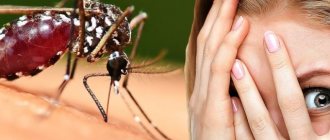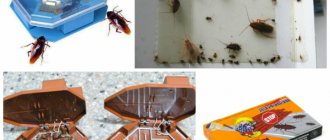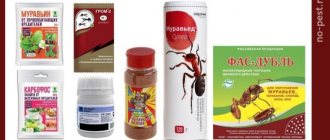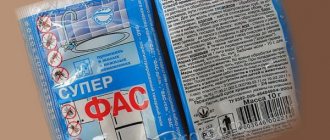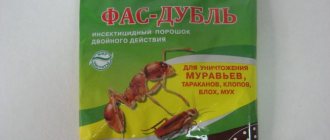Description and characteristics
Fipronil is a chemical pesticide substance of the phenylpyrazoles class, used to combat various types of harmful insects.
In its natural form it is a colorless powder with a distinct musty odor. Does not react to thermal influences, does not degrade in the presence of metals, and decomposes slowly in sunlight. Fipronil disrupts the passage of impulses through the membranes of nerve cells and blocks the functioning of the nervous system of pests. The death of the latter occurs on average 8 hours after treatment due to paralysis caused by overexcitation of the central nervous system. The duration of the protective effect of preparations based on this pesticide is 14 days.
The substance was developed by the French concern Ron-Pulec from 1985 to 1987, but 6 years later it entered the wide market under a US patent. A decade later, the patent rights for the production of products containing Fipronil were purchased by the international corporation BASF.
In this video you will learn about using Fipronil flea spray:
Toxicology
An absolutely selective neurotoxin is impossible, because The nervous system of animals is generally organized according to the same principles. Therefore, fipronil is a rather dangerous substance, and its toxicological indicators are by no means mild:
- LD50: rats 97 mg/kg body weight orally; 2000 mg/kg cutaneously. Mallard duck 2150 mg/kg; pheasant – 31 mg/kg. CK50 for Japanese carp 0.34 mg/l (96 hours); for daphnia 0.19 mg/l (48 hours). That is, the reaction of specific living organisms to fipronil is very individual.
- ADI for humans is 0.0002 mg/kg body weight.
- OBUV in the air of the working area – 0.1 mg/cu.m. m.
- OBUV in atmospheric air – 0.0001 mg/cu. m.
- MPC in soil – 0.05 mg/kg.
- MPC in water of reservoirs is 0.001 mg/m3. dm.
Symptoms of acute intoxication with fipronil, in order of development and/or degree of poisoning: nausea, causeless agitation, irritability, nervous tremors (tremor), lethargy (severe general lethargy up to lack of sensitivity to pain and restless sleep), convulsions, death. Mild poisoning goes away without treatment if the effect of the drug stops. In case of severe poisoning, treatment is symptomatic; There is no specific anidote. In addition, fipronil is currently the surest candidate for “devil poisons”: even mild poisoning with it after a long time affects the kidneys, liver, and thyroid gland. Research in this regard is far from complete (it takes a lot of time), but it seems that fipronil is no safer than the other “devil poison” thiuram (thiram).
Areas of application
Fipronil is a broad-spectrum enteric insecticide with moderate systemic properties and good residual activity. The peculiarities of the substance’s effect on the body of harmful insects make it possible to use it in the following areas:
- Agriculture. The pesticide shows high effectiveness against soil-dwelling, orthoptera and coleopteran pests, desert and migratory locusts, ground beetles, Colorado potato beetles, leech and tortoiseshell bugs. It can be used both for treating seeds and for spraying green mass during the growing season of plants, however, in the latter case, the scale of treatment is limited by the high toxicity of the substance. Insects pose a huge threat to agriculture
- Sanitary and medical disinsection. Products based on Fipronil are used to exterminate synanthropic cockroaches and ants in residential premises, health care and food complexes, industrial facilities, children's institutions, and so on. In medical disinfestation, only gels and bait stations are allowed.
- Veterinary medicine. The substance is often included in various preparations aimed at combating fleas and ticks.
It is worth noting that long-term use of Fipronil is fraught with the emergence of resistance, so it is advisable to alternate preparations based on it with other insecticides, including when used as food baits.
fipronil: basic information about the pesticide
Description: The insecticide used to control a wide range of pests, including thrips, rootworms, wireworms, weevils and termites.
Year of official registration: 1993
Release of pesticides onto the market (Directive 91/414/EEC), status:
| Status | Annex 1 |
| Speaker/co-speaker dossier | France |
| The enable date is about to expire | 30/09/2017 |
Approved (V) or known (#) in the following European countries:
| V | V | V | V | V | V | V | V | V | V | V |
Also registered in: Australia, USA
Basic information:
| Type of pesticide | Insecticide, Veterinary drug |
| Chemical Structure Group | Phenylpyrazoles |
| Nature of action | Wide spectrum with contact and stomach action. GABA-missing chloride channel antagonist. |
| CAS registration number | 120068-37-3 |
| Code CF (Enzyme Code) | 424-610-5 |
| International Cooperative Pesticide Review Council (CIPAC) code | 581 |
| US Environmental Protection Agency (US EPA) Chemical Code | — |
| Chemical formula | C12H4Cl2F6N4OS |
| SMILES | FC(F)(F)S(=O)c2c(C#N)nn(c1c(Cl)cc(cc1Cl)C(F)(F)F)c2N |
| International Chemical Identifier (InChI) | InChI=1/C12H4Cl2F6N4OS/c13-5-1-4(11(15,16)17)2-6(14)8(5)24-10(22)9(7(3-21)23-24) 26(25)12(18,19)20/h1-2H,22H2 |
| Structural formula | |
| Molecular weight (g/mol) | 437.15 |
| IUPAC name | 5-amino-1-(2,6-dichloro-α,α,α-trifluoro-p-tolyl)-4-trifluoromethylsulfinylpyrazole-3-carbonitrile |
| CAS name | 5-amino-1-[2,6-dichloro-4-(trifluoromethyl)phenyl]-4-[(trifluoromethyl)sulfinyl]-1H-pyrazole-3-carbonitrile |
| Other information | — |
| Herbicide resistance according to HRAC | Not determined |
| Insecticide resistance according to IRAC | 2B |
| Fungicide resistance according to FRAC | Not determined |
| Physical state | White powder |
Release:
| Index | Meaning | |||
| Pesticide Manufacturers |
| |||
| Commercial names of drugs containing a.v. |
| |||
| Associated with this substance: | — | |||
| Assessing the risk of a pesticide to the local environment (England) | No | |||
| Preparative form and application features | Often supplied as fine granules that are dissolved in water and used as a compost treatment or starter. | |||
Fipronil - hazard class for humans
It is difficult to imagine modern household chemicals without pesticides, or more precisely, insecticides , that is, products designed to kill insects.
The most common products in central Russia are anti-fly and mosquito repellents.
However, unlike these “seasonal” drugs, some residents also encounter much more unpleasant and annoying insects.
First of all, we are talking about cockroaches, which have enormous fertility and resistance to certain poisons, making them very difficult to destroy in residential areas.
There are not many effective and effective remedies for cockroaches, and one of them is fipronil. Fipronil (phenylprazole), a white powder with an unpleasant odor, is one of the most effective pesticides for a wide range of applications.
According to experts, this drug, included in baits against cockroaches, acts quickly and effectively. In particular, the first insects begin to die within 10-12 hours after its use.
The duration of action of one “dressing” is not too long (up to two to three weeks), but if you use it again within a month, you can completely get rid of annoying “household” insects (of course, provided that they do not constantly crawl into the house from neighbors or from other places outside the apartment).
In addition to household issues, fipronil was also actively used in agriculture - for the treatment of crops and trees.
Fipronil is especially successful in killing locusts , since even a small dose of the drug remaining after spraying on the grass and leaves can reliably destroy the pest.
Also, one of the ways to use the drug is to kill ticks and fleas in pets by treating their fur with it.
However, many residents, both apartments and farms, are interested in the potential danger of fipronil for people and pets. In this regard, first of all, it is necessary to explain what pesticides are and how they work.
Substances such as fipronil are a substance that, in a living body, blocks the transmission of nerve signals and disrupts the functioning of the nervous system. Due to this, small pests (ants, bedbugs, fleas, cockroaches), poisoned by the drug, quickly die.
However, by their nature, almost all living beings are the same, so this drug has a negative effect not only on insects, but also on larger organisms.
First of all, the use of fipronil is dangerous for honey bees, because these insects actively move from one flowering plant to another, after which they carry pollen and nectar into their “home”. If nectar and pollen are poisoned by fipronil, not only the bee that collected it will die, but also its “neighbors” in the hive.
In addition, this drug can cause certain harm to the health of both pets and humans. When using such a drug at home, you need to understand that its smell can attract not only insects, but also, for example, a cat or dog, which can eat the scattered bait and get poisoned.
Due to the fact that the body of a dog or cat is much larger than small insects, the lethal dosage of the drug is much higher (thousands of times). At the same time, the possibility of severe poisoning is also possible.
For this reason, in apartments where there are pets, any pesticides and insecticides should be used very carefully , ideally only during the period when the animal is not in the house. The same applies to small children, who are very inquisitive and can pick up even completely inedible objects from the floor and taste them.
Therefore, it is necessary to place the cockroach poison in such a way as to completely exclude the possibility of a small child coming into contact with it.
As for adults, contact of the drug with the skin can cause irritation, redness and itching, which, however, goes away quite quickly.
But if accidentally ingested, the drug can cause nausea, vomiting, headaches, weakness and fever. Most often, such symptoms pass quickly and do not require treatment, but in some cases, upon contact with fipronil, an allergic reaction (individual intolerance) may occur.
In this regard, when treating premises, crops or pet fur with fipronil, safety precautions must be observed. It is advisable to use special gloves and a respirator, and avoid contact of the drug with clothing, utensils, and food.
When using a drug to kill parasites on pets, you need to wash it off very quickly, not allowing the animal to lick the remaining drug from the fur. In addition, it is advisable not to use fipronil in apartments, houses or courtyards where pregnant women or small children are located.
Use in everyday life
Fipronil preparations Anti-cockroach-gel, Crossbow NEO, Magic drops, Brownie Proshka, Fumitox, Eslanadez are registered for everyday use in the Russian Federation. For household disinsection they are used in 3 ways (in order of decreasing total volumes of use):
- For fumigation against midges - flying blood-sucking insects;
- As a poisoned bait against synatropic insects - gel;
- As an insecticide for external use for non-food-producing pets.
About "bird" fipronil
There is also fipronil for sale on the Internet for birds, against feather eaters and external parasites. But, firstly, after a series of scandals in 2017-2018. with chicken eggs poisoned by fipronil, the treatment of egg-laying and meat poultry with fipronil is prohibited in almost all countries with developed commercial poultry farming. Secondly, given the huge range of species sensitivity of birds to this DV (see above), it is also highly undesirable to use it for disinsection of songbirds and ornamental birds.
Fipronil for diarrhea
Insecticides for free-living blood-sucking insects (mosquitoes, midges, black flies and bloodsuckers) are available in the forms of sprays, plates, spirals and bottles for electrofumigators, see figure:
Fipronil spray against mosquitoes is generally not a home remedy, but for non-electrified places - cottages, picnic areas, tents, etc. The smell of a weak solution of the drug is not felt by humans, so fragrances are added to sprays. But their smell is not as nasty as dichlorvos (otherwise you won’t be able to sell it). If there are a lot of midges, do not use fipronil for long and overdo it to the point of intoxication. Therefore, if fipronil anti-mosquito spray is sprayed in a room (especially in a cramped room, for example, in a tent), before people enter, it is ventilated until the smell completely disappears: the remnants of the drug that settle on the walls, floor and ceiling will be enough for the night.
Fumigation with fipronil is much safer and more economical, because Due to heating, DV metabolites that are not so dangerous, but quite effective from bloodsuckers, escape into the air behind the grille of the apparatus. Fumigators on plates and spirals are convenient, but plates and spirals are easily falsified. A solution of fipronil with a purity higher than 90% is colorless, and a counterfeit solution is slightly yellowish, and it is easy to distinguish a high-quality bottle from a dubious one by eye, so it is better to use fumigators under the bottles.
From home parasites
Gel-like fipronil against cockroaches, ants, earwigs and other synatropic insects is used in the forms of ointments and pastes with impurities of attractants (substances that attract parasites). It is also effective against herbivorous stink bugs that fly into rooms, as well as soldier bugs and woodlice that sometimes appear in houses. Although the latter are not insects, but land crustaceans, fipronil is also deadly for them.
Gel preparations of fipronil against house insects are available in tubes and syringes, see figure:
Insecticides with fipronil for synatropic insects
They should be used according to the instructions and with precautions, see above. There are also recommendations for the use of these products against silverfish (above in the figure on the right) and flycatchers (below).
silverfish and flycatcher
Baits are not effective against silverfish at all: these primitive insects feed on... house dust. The silverfish “will not fall for the bait”, and will not bite it with its weak jaws. In general, silverfish are completely harmless, harmless, do not spread any infection and lead a very secretive lifestyle. It makes sense to fight them if there are too many of them at home, which is extremely rare.
The flycatcher is a scary-looking, but very useful predatory insect from the order of centipedes. Her way of life is fully characterized by the name. The flycatcher does not spare other house insects: if it appears at least occasionally in sight, there will almost certainly be no cockroaches, bed bugs, etc. in the house. Like all centipedes (scolopendras, etc.), the flycatcher is poisonous, but talk about how it bit a child is either lies or panicky inventions. The flycatcher's jaws (centipedes do not have real jaws) are not capable of biting through the skin of a newborn baby, and humans are insensitive to its venom. Flycatchers themselves never climb on people, and if you catch one, it tries to escape as quickly as possible. But it is possible to kill a flycatcher with an insecticidal bait - if it eats a poisoned but still living insect.
For pets
There is a special situation with fipronil insecticidal preparations for cats and dogs. There is a failure here in the registration system for pesticides: they are neither zootechnical (since animals permanently living in the house are not considered productive), nor sanitary (a pet dog or cat is not necessary to ensure the livelihoods of its inhabitants), much less agrotechnical. On the other hand, no harmful effects of fipronil on canines and cats have been recorded, including purebreds (in the sense of preserving the purity of the breed during crossing). Therefore, insecticides for pets are sold either as veterinary drugs according to completely different rules, or, primarily. online, without registration at all. In Russia, this is how you can purchase imported single preparations of fipronil. Which, of course, in no way cancels the properties of this DV, the rules and precautions for handling it, see above.
To treat dogs and cats against fleas and ear mites, 0.25% fipronil spray is used under various names. This formulation of the drug poses the greatest danger to people, since the active substance is partially sprayed into the air. Therefore, it is not advisable to use simple BAU “spray bottles” (household aerosol packaging, item A in the figure). Much safer are sprays with a cap nozzle that limits the area of action of the drug, pos. B.
Fipronil preparations for treating dogs and cats against ticks and fleas
Instructions for using insecticides with fipronil to rid pets of external parasites are as follows:
- The treatment is carried out in a ventilated non-residential area using PPE (see above).
- Before using against ear mites, it is advisable to give the animal a light sedative, because The delicate skin in the auricle may itch from the drug at first.
- A sprayer with a jet limiter is brought to the animal’s fur so that the edges of the cap spread the fur apart, without touching the underfur - the most irritable of them react calmly to the movement of the fur.
- Spraying is carried out strictly according to the scheme and standards for a given species/breed in accordance with the instructions for a specific preparation.
- At the end of the treatment, stay with the pet in the room for half an hour.
- If the animal tolerates loneliness, leave it in the room for treatment for 2-4 hours before bringing it back into the living rooms.
- Otherwise, they are taken out for a walk for at least an hour. It is advisable to walk in warm, sunny places so that the solvent dries faster and the unabsorbed fipronil residues are converted into its metabolites.
- The pet is closely monitored for a week and children are not allowed to play with it. In case of any abnormal behavior or deterioration in health, he and/or their animal are shown to a veterinarian, and children are brought to an appointment with a toxicologist.
- Repeated treatment (if necessary) is carried out no earlier than 7 days after the first, unless otherwise indicated in the instructions for the drug.
Note: for additional information, see the video on the rules for treating pets for external parasites
Video: about treating animals with flea and tick spray
and about possible errors in doing so
Video: mistakes when handling pets
What if it itches?
Repeated use of external insecticides in case of severe infection often causes scabies in animals and gives other undesirable side effects, see for example. video clip:
Video: side effects of flea and tick spray
The reasons are irritation of the skin by the solvent or accumulation of residues of active substances in the pores of the skin and sweat glands. In the first case, the animal begins to itch intensely soon after treatment. When DV accumulates, it scratches every now and then after a few days. The scabies caused by the solvent will soon go away (if it does not result in severe scratching). “Cumulative” scabies gets worse over time.
Recently, preparations with fipronil from the Lux series have been intensively promoted on the Internet, supposedly not causing animals to itch. Judging by the commercials, in this case the solvent has been replaced. Long-term extensive experience with the use of fipronil “lux” has not yet been accumulated, and it is not yet possible to judge whether its active substances accumulate in the skin.
Advantages and disadvantages
The substance has a prolonged effect. Its presence in baits allows poisoned insects to return to the colony and spread the poison even after their own death. In particular, Fipronil against cockroaches helps kill 95% of pests, even if they did not use bait, but simply came into contact with feces and corpses of dead relatives. The same applies to ants - the complete destruction of their colony occurs within 3 days.
Among the advantages include resistance to precipitation: when sprayed, the pesticide remains 75% effective even after rain 40 minutes after application. In addition, almost all types of insects find the smell and taste of poison very attractive, which simplifies the procedure for their destruction. However, you should also be aware of the negative characteristics of the substance , in particular:
- potential danger to aquatic fauna (including aquarium inhabitants);
- high toxicity to pollinating insects;
- tendency to accumulate in soil, tissues of treated plants and animal organisms;
- toxicity to birds (subject to ingestion of the pesticide).
The effectiveness of the product - benefits and harms
If we take into account the cascade effect, the mortality rate of cockroaches and other insects can reach up to 95% already in the first 3 days. The product has pronounced toxic properties because its smell and taste are not unpleasant for pests. Therefore, they swallow the poison with pleasure.
Cockroach corpses and feces remain filled with a sufficient amount of toxic substance to destroy healthy parasites. The benefits of this component of the drugs are great in other areas - it is used as the main component of anti-flea products for pets and to combat pests that cause damage to the agricultural sector.
The harm of the product lies in its high degree of toxicity to fish and invertebrate creatures living in water. Its ability to combine with sediments and low solubility in water can reduce the danger. This is relevant for owners of aquarium fish who plan to use drugs in the form of a spray.
The described component is also destructive for bees. If you have parrots or other birds in your apartment or house, remember that if they swallow drugs with this component, there may be undesirable consequences for their health. It is recommended to limit the movement of birds around the premises for at least a month, which should pass from the moment of treatment.
Instructions for use
Fipronil is included in a variety of drugs, each of which has its own purpose, so there are no universal instructions for it - in each specific case you must follow the instructions provided by the manufacturer. The only condition common to all drugs is compliance with standard safety measures:
- While working with the substance, drinking, smoking and eating are prohibited. The face should be protected with a special mask, hands with gloves, and body with tight-fitting clothing to prevent the drug from coming into contact with exposed skin. Take precautions when treating with Fipronil to avoid poisoning
- The dishes that were used to prepare the working solution should not subsequently be mixed with kitchen utensils.
- Fipronil should not be used near ponds or aquariums. During treatment, there should be no small children or pregnant women nearby. If the drug is used as part of a food bait, the latter is positioned so that the child cannot reach it.
- At the slightest symptoms of poisoning (dizziness, nausea, vomiting, general weakness, etc.), you should immediately consult a doctor.
Anti-flea products with Fipronil are contraindicated for puppies and kittens under two months of age, as well as adult animals with weakened immune systems.
The substance has the first and third classes of danger for pollinating insects (depending on the purpose of the drug, which includes Fipronil). Hazard classes for humans - second and third.
Use of fipronil in different countries
If you had to buy non-domestic drugs, then take into account the following information.
- Manufacturers in the USA and China produce a drug called Regenta. The product, which contains fipronil, effectively gets rid of cockroaches, grasshoppers, and locusts. And it is capable of destroying the larvae of coleopteran insects in fertile soils.
- Also in America, several more effective drugs are produced - “Goliath” and “Nexa”, which are designed to combat cockroaches and ants. Chipco Choice is designed to treat lawns against various pests.
- In Kazakhstan and surrounding countries, fipronil is known as "Adonis". An indispensable means for exterminating grasshoppers, locusts and cockroaches.
- Several US states - Alaska, Connecticut, Washington, Nebraska, Indiana and New York - have approved the use of the Termidor insecticide to kill the "crazy ants" Anoplolepis gracilipes.
- In England, such insecticides have received approval for use in public areas.
All of the above drugs are very effective in ridding your home of pests if you use the substances for treatment inside a house or apartment.
Fipronil is included in various adhesive and gel traps
Our most popular fipronil-containing drugs are “Regent”, “Executioner” and “Brownie”.
"Regent" from cockroaches
It is very difficult to find an original product produced by Ron-Puenk in our stores. And besides, this drug is one of the most frequently counterfeited. It is much easier to buy Regent on the Internet. Remember: when purchasing a product, ask the consultant to present a certificate of conformity of the product, this is the only way you can make sure that the drug is not a fake.
A substance such as fipronil appeared not so long ago, so pests have not yet developed immunity to this insecticide. The drug remains one of the most effective in pest control. “Regent” is a substance that is not intended to destroy a specific type of pest; it is a universal product, produced in powder form. Preparing an emulsion for treating a room is quite simple - you just need to dilute the product with water in the required proportions.
Important! To kill insects in a garden or vegetable garden, you just need to thoroughly treat the leaves of the crops and the pests will easily absorb the insecticide. In the case of fighting cockroaches, spraying the room alone will not be enough; the effectiveness of this method is low.
These domestic pests have a chitinous cover that is quite strong and dense, so the poison may simply not enter their body through contact. Accordingly, the process of exterminating cockroaches can be long and ineffective. Given this feature of the drug, experts recommend using it in the form of bait. Insects absorb them, the insecticidal substance enters the cockroach’s body, destroying it.
What is Fipronil
Fipronil (also known as Regent, Cosmos and Adonis) is a pesticide (phenylpyrazoles). A modern product designed to kill insects. Refers to insecticides and agricultural acaricides. The affinity is popular, so it is increasingly asked about if problems with parasites arise.
Fipronil was discovered and developed by French scientists from the Rhone-Poulenc chemical concern. This happened back in the period from 1985 to 1987. It was widely used in 1993 in the USA. Fipronil served well and, unlike Dust, was not banned. In Russia, fipronil has also long been guarding agricultural fields and ordinary Russian apartments.
Where is it used and how does it work?
In fact, it is a broad-spectrum insecticide found in many industrial and household insect repellents. The principle of action is based on a toxic effect on insect cells, leading to their destruction. The central nervous system of insects, due to blocking GABA-bound chloride and glutamate channels, ultimately leads to an almost complete stop in the transmission of nerve impulses. It is used as in everyday life - means to combat bedbugs, ants and cockroaches; and cultural pests in the agro-industrial sector - in fields, forests, etc.
Supplied as:
- 80% Water-dispersible granule;
- 4% Emulsion Concentrate.
Efficiency of application
Quite effective considering the initial properties of fipronil. But most often it is contained as one of the components of the poison, so the final result may vary. But most of all, anti-parasite remedies hit ants and cockroaches, because... the intestinal contact effect is enhanced when the substance is ingested. Actually, this happens quite often, because insects do not find fipronil to taste unpleasant.
It is also known that poisoned cockroaches die rather slowly but surely. During this time, they manage to climb deeper, where they defecate with feces containing processed poison. After death, cockroaches eat their relatives, which only enhances the effect, because fipronil is easily preserved in insect corpses in a dose sufficient to cause poisoning. The situation with ants is even more pleasant. The individuals responsible for delivering food to the anthill do not have time to die immediately after the sample (as happens with ordinary poison), but they still have time to deliver the bait to the queen. This makes a very significant contribution to the fight against parasitic ants.
Residual effect: high.
Toxicity of fipronil
Unfortunately, the killing properties of the pesticide do not cancel the harmful effects of the poison on the environment and animals. The first thing, of course, is harm to animals. Birds and small warm-blooded pets are most often affected. In their body, as well as in the body of fish/invertebrates, the toxic substance tends to accumulate. In plants, as well as soil and water, the compound is oxidized to fipronil sulfone. It is also worth noting that preparations based on fipronil almost always belong to the first and third classes of danger for bees. For a person - to the second, third classes.
Verdict: Ready to use. Extremely effective. Recommended for household treatments.
"Executioner" from cockroaches
The drug is manufactured in Germany. Both at home and in our country, it is the most common means for combating various household pests. “Executioner” is highly effective, economically used, low-toxic, and has no pungent odor. But along with the growth of its popularity, the number of counterfeits of the drug began to increase. Therefore, today it is possible to buy the original product only in Germany, or through certified online stores.
Important! The main active component in “Executioner” can be not only fipronil, but also fenthion. Both of these substances are equally effective at killing insects.
The product is sold as a concentrate. To prepare an insecticidal solution, you need to mix the substance with water. If there are a lot of cockroaches in the house, then spraying alone will not be enough; to achieve the best results, you must also use the drug in the form of bait.
Insecticide "Brownie Proshka"
Gel "Proshka Domovoy" showed high efficiency
This product may seem unsightly, and it is not at all advertised. But it is worth noting that the drug is domestically produced, comes in a convenient gel form, and contains a high percentage of such an effective substance as fipronil against cockroaches. By purchasing this gel, you already receive a ready-made bait, which you only need to apply at home to the expected places of movement of pests.
“Domovoy Proshka” has many advantages: it contains the effective component fipronil, the product is convenient to distribute and apply, has a low cost, but is of good quality. But when working with any insecticides, do not forget about the rules of personal safety.
Fipronil is a toxic substance that is included in many effective drugs for killing various household pests. Due to its high toxicity, the drug cannot be used to treat rooms where children or pets live. Often, if you work carelessly with fipronil, a person experiences headaches, nausea, dizziness and skin irritation.
Spray Baron
Available in 100 ml bottles. Contains 0.3% concentration of the active ingredient – Fipronil. It takes 4-7 days to destroy a complete colony of cockroaches. The product should be sprayed at a distance of 25 centimeters from the treated area.
Places to use the spray:
- space under or behind the kitchen stove;
- space under the sink and refrigerator;
- space near the microwave and trash can;
- under the bath;
- along the perimeter of ventilation holes and inspection hatches;
- along the baseboards;
- in the area of the entrance door.
Usually a single treatment with Baron is enough for an acceptable result, but it is better to repeat the procedure after 1-2 weeks. To treat an area of 50 sq. meters, one can of spray is enough.
Regent
Produced in France. The product contains 0.5 grams of water-soluble granules. The volume of the bottle is 100 grams, in which the concentration of Fipronil corresponds to 800 grams per kilogram of the drug.
The most economical option. It is safe for the interior, as it does not damage wallpaper or furniture upholstery. There is no unpleasant odor, which is the problem with many other types of products with Fipronil (the same Baron spray).
After treating the room with X-ray, you cannot enter it for 3 hours. To prevent the accumulation of volatile substances, before leaving the treated room, all windows should be opened, but the doors should be closed.
Gel Eslanadez
Contains two active ingredients: Fipronil 0.03% concentration and Imidacloprid 0.5% concentration. One of the most powerful means for fighting cockroaches, but it is also the most unsafe for humans and pets.
Provides long-term protection against the return of parasite colonies - up to two months. Available in the form of syringes containing 20 or 50 ml of gel. The tube contains 30-75 grams of the substance. The gel is colorless. After the initial treatment, repeat treatment should be done after 2 weeks.
A dozen insecticidal products are made based on Fipronil (most are produced in European countries)
Before using the gel, you need to thoroughly clean the room and remove all visible food crumbs (so that the cockroaches eat the gel). The advantage of the gel is that it can be applied to areas that are inaccessible to other means.
One of the components of Eslanadez is Bitrix, a very bitter substance that makes the gel safe. The fact is that after tasting the gel, any pet will not want to eat it. Thus, the manufacturer managed to achieve safety for using the gel in apartments.
Action and composition
The effect of the spray is similar to other insecticides. It all happens as follows: after the substance is applied to the surface, the cockroach runs over it and the toxic chemical ends up on the body. Then it penetrates the chitinous shell and affects the nervous system, paralyzing the adult and causing death. The advantage is that there is no need for absolutely all cockroaches to walk across the treated surface and come into direct contact with the applied drug. The fact is that one individual carrying the substance infects others, so the death of the entire colony occurs quite quickly.
The main active substance in the drug is fipronil; it has a fairly wide spectrum of action. It is very often used in insecticidal products, which are available in the form of a gel and bait. In addition, it is used against fleas on pets. Unfortunately, this substance has a drawback; the fact is that with repeated use of the spray, cockroaches become addicted, so further use is not effective.

